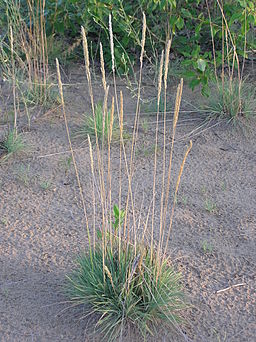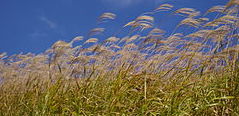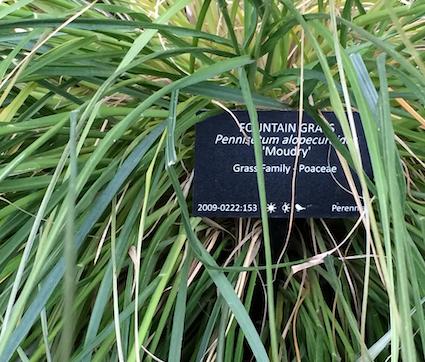- Plant IDs
- >
- ID By Type
- >
- Grasses
Grasses may the most important plant species in existence. They belong to the family known as Gramineae or Poaceae. Cultivated species of barley, millet, oats, rice, rye and wheat are the basic foods of most peoples. They are also used extensively in construction and landscaping.
The grass bed near the Plaza has many interesting varieties of grasses, and other varieties are scattered throughout the Garden. Grasses have stems that are hollow and most belong to the Poaceae family. Among them are:
Acorus gramineus: Grass-leaf sweet flag is native to eastern Asia and likes its feet wet. We have several cultivars. It is not a true grass, but its leaves look like blades of grass. It also has a citrus scent when pinched.
Arrhenatherum elatius subsp. bulbosum 'Variegatum': Striped tuber oat grass has soft, silvery blades and is drought-tolerant.
Bouteloua gracilis: Also called blue grama or mosquito grass, this genus is named after two Spanish botanists, Claudio and Esteban Boutelou. There is a blond variety in the Backyard Bird Garden. It is native to North American prairies. The "mosquitos" refer to the flowers which hover about the foliage and look like dried insects.
Briza media: Quaking grass is native to Eurasia, and its seeds are an important food source for birds.
Calamagrostis: Reed grass or smallreed is often reed-like, hence the name, as kalamos is the Greek word for grass. There are about 260 species, 3 of which we have in our Garden.
Carex: These perennial grasses are true sedges, and there are over 2000 species. We have about 10 species and several cultivars.
Cortaderia selloana: Pampas grass is native to the pampas of South America and can grow to 10 feet. Its large flowers are appreciated in landscaping. It is used to feel livestock in its native area.
Deschampsia cespitosa: Tufted hair grass or tussock grass is native to grasslands of several continents. It is a beautiful ornamental plant, with many cultivars.
Elymus: This genus is related to cereals grains and is often called wild rye, wheat grass or couch grass. E. canadensis is native to North America, while E magellanicus, blue wheat grass, is native to South America.
Hakonechloa: Bunch grass or hakone grass is native to eastern Asia and likes shade. We have several cultivars grown for their intense colour.
Helictotrichon sempervirens: Blue oat grass is pale green with a tinge of blue.
Imperata cylindrica 'Rubra': Japanese blood grass has striking red blades but is invasive in some areas.
Koeleria: This grass is found on all continents and has many species. K. glauca has beautiful flowers and foliage.
Milium effusum 'Aureum': Bowles golden grass has beautiful golden blades and flowers.
Miscanthus: Silvergrass is a genus native to several parts of the world. We have M. 'Purpurescens' (flame grass), which has beautiful fall foliage; several cultivars of M. sinensis, Japanese silver grass; and the tall M. transorrisonensis.
Molinia caerulea: Purple moor grass has purple spikelets, hence the epithet caerulea which means "deep blue."
Ophiopogon japonicus: Mondo grass or monkey grass sports pale flowers followed by dark berries. Ophiopogon planiscapus 'Nigrescens' has beautiful black foliage.
Panicum virgatum: Switch grass grows to 6 feet. Panicum is an old word for millet.
Pennisetum alopecuroides: Fountain grass has lovely bottle-brush flowers, and cultivars come in many colours.
Saccharum ravennae: Plume grass looks similar to pampas grass but is hardier and native to the Mediterranean.
Schizachyrium scoparium: Commonly known as little bluestem, its bluish blades can reach 4-5 feet in height by the end of the summer. We have several cultivars. It is very drought-tolerant and does well in poor soil.
Stipa gigantea: Giant needle or feather grass can grow to 8 feet and is a Great Plants Pick for our area.
Banner Photo of Carex flagellifera by Midge Oke
Acorus gramineus: Grass-leaf sweet flag is native to eastern Asia and likes its feet wet. We have several cultivars. It is not a true grass, but its leaves look like blades of grass. It also has a citrus scent when pinched.
Arrhenatherum elatius subsp. bulbosum 'Variegatum': Striped tuber oat grass has soft, silvery blades and is drought-tolerant.
Bouteloua gracilis: Also called blue grama or mosquito grass, this genus is named after two Spanish botanists, Claudio and Esteban Boutelou. There is a blond variety in the Backyard Bird Garden. It is native to North American prairies. The "mosquitos" refer to the flowers which hover about the foliage and look like dried insects.
Briza media: Quaking grass is native to Eurasia, and its seeds are an important food source for birds.
Calamagrostis: Reed grass or smallreed is often reed-like, hence the name, as kalamos is the Greek word for grass. There are about 260 species, 3 of which we have in our Garden.
Carex: These perennial grasses are true sedges, and there are over 2000 species. We have about 10 species and several cultivars.
Cortaderia selloana: Pampas grass is native to the pampas of South America and can grow to 10 feet. Its large flowers are appreciated in landscaping. It is used to feel livestock in its native area.
Deschampsia cespitosa: Tufted hair grass or tussock grass is native to grasslands of several continents. It is a beautiful ornamental plant, with many cultivars.
Elymus: This genus is related to cereals grains and is often called wild rye, wheat grass or couch grass. E. canadensis is native to North America, while E magellanicus, blue wheat grass, is native to South America.
Hakonechloa: Bunch grass or hakone grass is native to eastern Asia and likes shade. We have several cultivars grown for their intense colour.
Helictotrichon sempervirens: Blue oat grass is pale green with a tinge of blue.
Imperata cylindrica 'Rubra': Japanese blood grass has striking red blades but is invasive in some areas.
Koeleria: This grass is found on all continents and has many species. K. glauca has beautiful flowers and foliage.
Milium effusum 'Aureum': Bowles golden grass has beautiful golden blades and flowers.
Miscanthus: Silvergrass is a genus native to several parts of the world. We have M. 'Purpurescens' (flame grass), which has beautiful fall foliage; several cultivars of M. sinensis, Japanese silver grass; and the tall M. transorrisonensis.
Molinia caerulea: Purple moor grass has purple spikelets, hence the epithet caerulea which means "deep blue."
Ophiopogon japonicus: Mondo grass or monkey grass sports pale flowers followed by dark berries. Ophiopogon planiscapus 'Nigrescens' has beautiful black foliage.
Panicum virgatum: Switch grass grows to 6 feet. Panicum is an old word for millet.
Pennisetum alopecuroides: Fountain grass has lovely bottle-brush flowers, and cultivars come in many colours.
Saccharum ravennae: Plume grass looks similar to pampas grass but is hardier and native to the Mediterranean.
Schizachyrium scoparium: Commonly known as little bluestem, its bluish blades can reach 4-5 feet in height by the end of the summer. We have several cultivars. It is very drought-tolerant and does well in poor soil.
Stipa gigantea: Giant needle or feather grass can grow to 8 feet and is a Great Plants Pick for our area.
Banner Photo of Carex flagellifera by Midge Oke
Grasses

Acorus gramineus
CA$0.00
CA$0.00

Arrhenatherum elatius subsp. bulbosum 'Variegatum'
CA$0.00
CA$0.00

Bouteloua gracilis
CA$0.00
CA$0.00

Briza media
CA$0.00
CA$0.00

Calamagrostis x acutiflora 'Overdam'
CA$0.00
CA$0.00

Carex flagellifera
CA$0.00
CA$0.00

Carex oshimensis 'Everillo'
CA$0.00
CA$0.00

Cortaderia selloana
CA$0.00
CA$0.00

Deschampsia cespitosa ‘Goldtau’
CA$0.00
CA$0.00

Elymus
CA$0.00
CA$0.00

Hakonechloa macra 'All Gold'
CA$0.00
CA$0.00

Helictotrichon sempervirens
CA$0.00
CA$0.00

Hystrix petula
CA$0.00
CA$0.00

Imperata cylindrica 'Rubra'
CA$0.00
CA$0.00

Koeleria glauca
CA$0.00
CA$0.00

Miscanthus sinensis
CA$0.00
CA$0.00

Milium effusum 'Aureum'
CA$0.00
CA$0.00

Molinia caerulea
CA$0.00
CA$0.00

Panicum virgatum
CA$0.00
CA$0.00

Pennisetum alopecuroides
CA$0.00
CA$0.00

Pennisetum alopecuroides 'Moudry'
CA$0.00
CA$0.00

Saccharum ravennae
CA$0.00
CA$0.00

Schizachyrium scoparium
CA$0.00
CA$0.00

Stipa gigantea
CA$0.00
CA$0.00

Nassella tenuissima
CA$0.00
CA$0.00
Proudly powered by Weebly